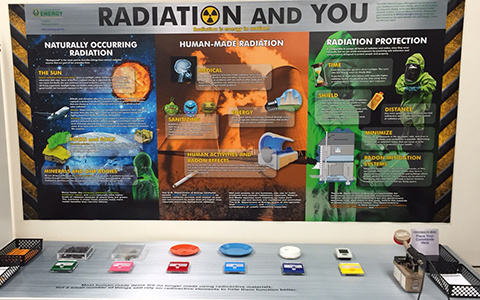A newly updated radiation exhibit, created by the U.S. Department of Energy (DOE) Office of Legacy Management (LM) office in Grand Junction, Colorado, was recently unveiled at the John McConnell Math and Science Center. The January 7, 2016, Family Night event also introduced other new collections, including a bird-watching exhibit and a 3D virtual erosion table. The newest exhibits reinforce the Center’s aim to demonstrate its increased focus on STEAM—science, technology, engineering, art, and math—education.
LM’s new “Radiation and You” exhibit combines information and demonstrations from its previous display with updated information and feedback from stakeholders wanting to know more about naturally occurring and human-made sources of radiation, and ways to reduce exposure to our surroundings and ourselves. Also, incorporated are eye-catching graphics, a radioactive-material detector (Geiger–Müller probe), testing materials, a questionnaire for pre- and post-testing responses, and a feedback survey.
Physicist John McConnell spent 16 years of his 30-year scientific career at Los Alamos National Laboratory in New Mexico. When he decided to retire, John filled the trunk of his car with a variety of scientific materials, and created a mobile laboratory to deliver experiments and presentations to school-age children throughout western Colorado.
As his traveling science center grew in popularity, so did the number of exhibits and equipment. In January 2000, with assistance from enthusiastic contributors, John created a more grounded, interactive learning establishment in a Grand Junction elementary school. It was originally named the Western Colorado Math and Science Center.
LM’s original exhibit in the Center was geared toward high school–level students, but in recent years, attendance by elementary-aged children increased. For its updated display, LM obtained reviews from experts with the Colorado Department of Public Health and Environment.
A unique collaboration between the John McConnell Math and Science Center and the local Colorado Mesa University’s growing engineering program will allow the Center to relocate to a larger facility within the University’s campus. The new, central location will provide the perfect venue by allowing greater accessibility to a larger, more age-diverse audience. LM continues to meet its outreach and education goals by staying involved and contributing this—and hopefully more—informational exhibits to centers and events designed to keep students and the community excited about STEAM concepts. Informing the community about LM’s history with uranium, and continuing activities will ensure its actions protect human health and the environment for decades to come.
| Visitors can use the Geiger–Müller probe (at right) to detect radiation levels in an assortment of provided materials. |


